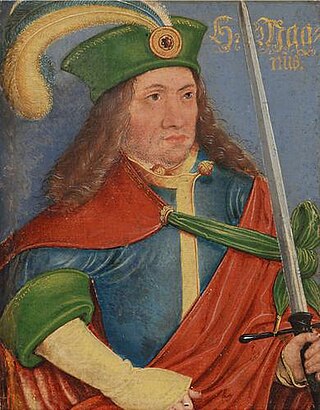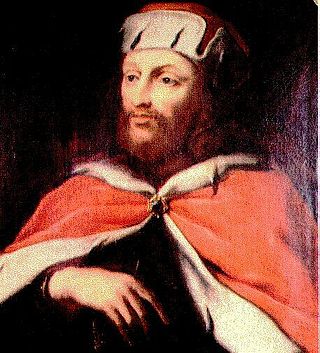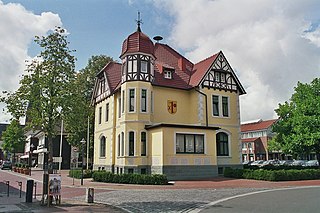
The House of Billung was a dynasty of Saxon noblemen in the 9th through 12th centuries.

Henry the Proud, a member of the House of Welf, was Duke of Bavaria from 1126 to 1138 and Duke of Saxony as well as Margrave of Tuscany and Duke of Spoleto from 1137 until his death. In 1138 he was a candidate for the election as King of the Romans but was defeated by Conrad of Hohenstaufen.

The Duchy of Saxony was originally the area settled by the Saxons in the late Early Middle Ages, when they were subdued by Charlemagne during the Saxon Wars from 772 and incorporated into the Carolingian Empire (Francia) by 804. Upon the 843 Treaty of Verdun, Saxony was one of the five German stem duchies of East Francia; Duke Henry the Fowler was elected German king in 919.

The House of Welf is a European dynasty that has included many German and British monarchs from the 11th to 20th century and Emperor Ivan VI of Russia in the 18th century. The originally Franconian family from the Meuse-Moselle area was closely related to the imperial family of the Carolingians.

Magnus was the duke of Saxony from 1072 to 1106. Eldest son and successor of Ordulf and Wulfhild of Norway, he was the last member of the House of Billung.
Otto of Nordheim was Duke of Bavaria from 1061 until 1070. He was one of the leaders of the Saxon revolt of 1073–1075 and the Saxon revolt of 1077–1088 against King Henry IV of Germany.
The Elder House of Welf was a Frankish noble dynasty of European rulers documented since the 9th century. Closely related to the Carolingian dynasty, it consisted of a Burgundian and a Swabian group. It has not been definitively clarified, however, whether the two groups formed one dynasty or whether they shared the same name by coincidence only. While the Elder House became extinct in the male line with the death of Duke Welf of Carinthia in 1055, his sister Kunigunde married into the Italian House of Este and became the ancestor of the (Younger) House of Welf.

Welf I was Duke of Bavaria from 1070 to 1077 and from 1096 to his death. He was the first member of the Welf branch of the House of Este. In the genealogy of the Elder House of Welf, he is counted as Welf IV.

Alberto Azzo II, Margrave of Milan, and Liguria, Count of Gavello, Padua, Rovigo, Lunigiana, Monselice, and Montagnana, was a powerful nobleman in the Holy Roman Empire. He is considered the founder of Casa d'Este, having been head of the first family to be master of Este, a town of Padua.

Otto I, called the Redhead, was Duke of Bavaria from 1180 until his death. He was also called Otto VI as Count Palatine of Bavaria from 1156 to 1180. He was the first Bavarian ruler from the House of Wittelsbach, a dynasty which reigned until the abdication of King Ludwig III of Bavaria in the German Revolution of 1918.
The Brunonids were a Saxon noble family in the 10th and 11th centuries, who owned property in Eastphalia and Frisia.

Dinklage is a town in the district of Vechta, in Lower Saxony, Germany. It is situated approximately 13 km southwest of Vechta, and 45 km north of Osnabrück.

Gertrude of Sulzbach was German queen from 1138 until her death as the second wife of the Hohenstaufen king Conrad III.

William II, Duke of Brunswick-Lüneburg was the Prince of Lüneburg from 1330 to 1369.

The Saxon revolt refers to the struggle between the Salian dynasty ruling the Holy Roman Empire and the rebel Saxons during the reign of Henry IV. The conflict reached its climax in the period from summer 1073 until the end of 1075, in a rebellion that involved several clashes of arms.
Sophia of Hungary, a member of the royal Árpád dynasty, was a Margravine of Istria and Carniola from about 1062 until 1070, by her first marriage with Margrave Ulric I, as well as Duchess of Saxony from 1072 until her death, by her second marriage with Duke Magnus Billung.
Richenza was a German noblewoman. By her first marriage, she was Countess of Werl. By her second marriage, she was Countess of Northeim, and from 1061 to 1070, Duchess of Bavaria.
Herman II, Count of Winzenburg was a son of Herman I, Count of Winzenburg and his second wife, Hedwig. She was either Hedwig of Assel-Woltingerode or Hedwig of Carniola-Istria. Herman II succeeded his father as Count of Winzenburg, without achieving the dominant position his father had held. He was a loyal supporter of Archbishop Adalbert of Mainz for many years.
Ethelinde of Northeim was the daughter of Otto of Northeim and the wife of Welf I, Duke of Bavaria, and Herman of Calvelage.
The County of Diepholz, that was first known as the Lordship of Diepholz, was a territory in the Holy Roman Empire in the Lower-Rhenish-Westphalian Circle. It was ruled by the Noble Lords, later Counts, of Diepholz from the late tenth century until 1585, when it was mostly incorporated into the Duchy of Brunswick-Lüneburg.











